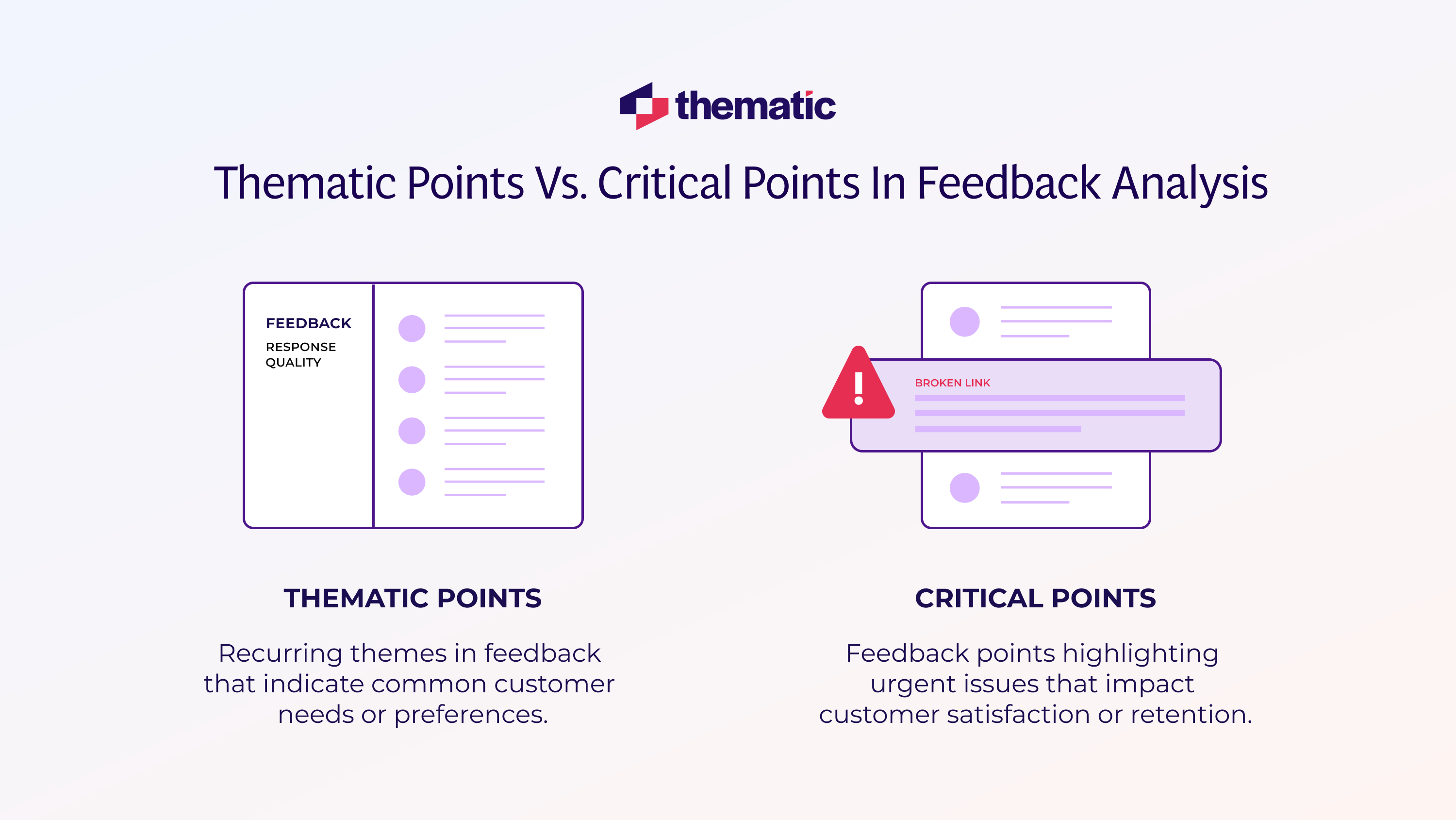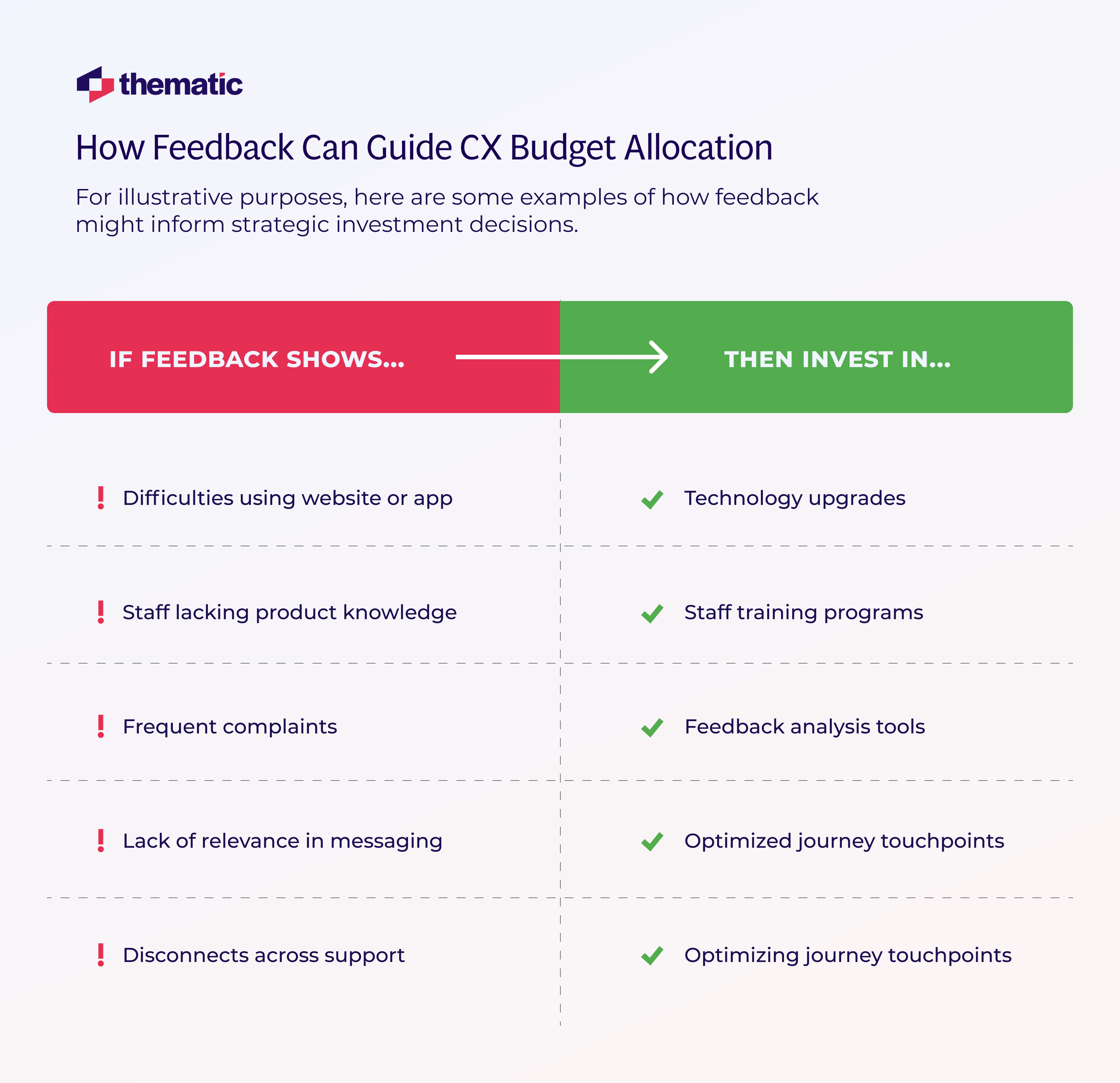
Discover practical ways to use thematic and critical points in feedback analysis to make informed CX investment decisions.

Investing in customer experience (CX) initiatives pays off—research shows a $1B company can gain an extra $700M in revenue within 3 years by improving CX. The challenge is knowing where to invest for maximum impact.
Enter thematic analysis—analyze customer feedback for recurring patterns and urgent concerns. When you analyze customer feedback at scale, CX teams can uncover what matters most—what’s working, what’s not, and where the biggest opportunities lie.
In this article, we’ll explore how to use thematic points and critical points in feedback to guide smart, targeted CX investments.
From digital upgrades to employee training, personalization, journey mapping, and more, here are ways to use feedback to drive better decisions and results.
But before we dive into the guide, let’s define thematic points and critical points.
Thematic points are patterns in feedback that show up again and again—common frustrations, suggestions, or expectations that reflect widespread customer needs.
Examples:
Critical points are high-impact issues that may only be mentioned once or twice but carry serious weight. They are often tied to churn, product failure, or brand damage.
Examples:
These two types of insight are what make thematic analysis such a powerful tool for CX teams managing large volumes of feedback. And in this article, well go through how you can use these two to decide where to invest more.

When deciding where to invest in CX, digital transformation should be high on your list. Customers expect seamless online experiences, and they’ll tell you when something’s off. That’s where thematic analysis comes in.
Customer comments like “the app crashes at checkout” or “site navigation is frustrating” signal recurring pain points. These are thematic points—patterns that emerge multiple times. Using AI-powered qualitative data analysis tools makes it easier to surface these themes at scale.
Say dozens of users flag confusing menus or missing self-service options. These aren’t one-off complaints—they indicate broader friction that needs fixing. Thematic analysis software helps group and quantify this feedback so you know what to prioritize.
Given that 74% of customers expect digital experiences to be as smooth as in-person ones, resolving these gaps directly impacts satisfaction.
Once themes are clear, focus your tech budget on the biggest friction points.
The data-driven prioritization prevents wasting resources on features customers don’t need. For example, glowing reviews of your mobile app suggest it’s working—no extra spend needed. But if your payment system is the source of multiple complaints, that’s where budget should go.
81% of businesses say digital CX is “extremely or very important” to success. Amazon even linked milliseconds in load time to billions in lost revenue. These are real stakes. Use thematic points and critical points to guide investment decisions and fix what matters most.
Investing in employee training is one of the most direct ways to improve customer experience. When staff are knowledgeable and engaged, they deliver better service. And feedback tells you where they shine—and where they need help.
Customers often comment on their interactions with employees. Statements like “the rep didn’t know the product” or “the agent was helpful and kind” are clues. Analyzing this feedback reveals both thematic points (e.g., inconsistent knowledge) and critical points (e.g., a customer left due to rudeness).
Themes may point to system-wide training needs, like product knowledge or response times, while critical feedback might spotlight isolated incidents that still have major consequences. Identifying both lets you prioritize your training investment strategically.
Ask yourself: Are certain locations or teams mentioned often? Are complaints tied to a specific product or service line?
The answers tell you where training will have the greatest impact.
Once you know where performance is falling short, allocate budget accordingly.
This targeted approach pays off: companies with well-trained teams see 10% higher customer loyalty and 23% higher profitability on average.
Even small steps, like onboarding updates or mentorship programs, can yield big gains. The key is to align your employee experience (EX) investments with the gaps revealed in your customer feedback.
When employees feel supported and equipped to succeed, they deliver the kind of service that drives loyalty. And when customer feedback drives those training investments, you ensure that budget goes to the areas that matter most to your customers.
Customer feedback is packed with insight—but only if you can make sense of it at scale. Thematic points show up as recurring patterns. Critical points surface risk or urgency. Both are essential to guiding smart CX investments.
Manually reading thousands of reviews, support tickets, or survey responses? Not scalable. You need thematic analysis software. Tools like Thematic use AI (NLP or LLM) to categorize and summarize open-ended feedback, turning noise into clarity in minutes, not months.
For example, DoorDash used Thematic to analyze tens of thousands of NPS responses from customers, drivers, and merchants. What emerged? A dashboard of common themes—something nearly impossible to create manually.
Thematic analysis groups and quantifies themes, while sentiment scoring reveals how customers feel. You can also identify subtle, emerging issues that haven’t hit critical mass yet. The result? A clear direction for where to invest.
Insight means little without action. You to act, and you need to tell your customer that you acted. That’s “closing the loop”—letting them know they were heard. Doing this means budgeting for a support ticketing system, a cross-functional CX task force, or integrations that assign critical feedback (like bugs or delivery complaints) directly to the teams responsible.
Some of this can be automated. If a scathing NPS comment comes in, Thematic, for example, can flag it for immediate follow-up. That’s real-time action.
Organizations that act on feedback—not just collect it—see better retention, higher CSAT, and more ROI. The Forrester TEI study highlighted the “making data-driven decisions, closing the customer feedback loop, and offering influential customer insights” as significant benefits of feedback analysis initiatives.
When you invest in tools that not only surface insights but help your teams act on them, your feedback strategy becomes a revenue strategy.
Cut through marketing noise and be sure you are asking the right questions in sales calls and demos. Our guide can save you time by helping you understand what you need for effective feedback analysis.
Download your free copy today!
Customers don’t just appreciate personalized experiences—they expect them. According to Salesforce, 73% of customers now demand better personalization as technology advances.
But personalization that works goes beyond using names in emails. It requires understanding what different customers actually want—and what frustrates them. Thus, you need thematic analysis so you can identify recurring feedback themes and surface critical points. Once you do this, you can shape personalization that feels relevant, not robotic.
Feedback analysis helps you spot preference trends at scale. Say you’re a SaaS provider: maybe small businesses want more tutorials, while enterprise clients want deeper customization. These themes help you tailor experiences for each segment.
Customers often voice frustrations like “recommendations weren’t relevant” or “I never get updates on features I care about.” These are critical signals your personalization may not be hitting the mark. With feedback analysis, you cluster these inputs into actionable insights—something product usage data alone can’t offer.
Thematic analysis reveals what’s missing, what’s wanted, and what’s working. That insight powers meaningful experiences across channels—from content and offers to product features.
In short, feedback provides the voice of the customer to guide your personalization investments.
Once you’ve surfaced clear themes and pain points, direct your budget where it matters most.
Spending on personalization is on the rise. Many CX teams are adopting CDPs and AI-based recommendation engines. Why? Personalization drives loyalty and revenue. Customers spend up to 140% more after a positive experience, and personalization is often what makes the experience positive.
Even small changes, like tailoring knowledge base content based on past queries, make interactions feel more thoughtful. And this pays off.

Today’s customers switch between channels—chat, email, phone, and social media—expecting consistent, seamless support. But when those channels operate in silos, the experience breaks down.
Feedback often reveals where the cracks are. That’s why analyzing support interactions by channel—and surfacing both thematic and critical points—is essential for smart CX investment.
Start by looking at feedback segmented by support channel. A review like “No one answered my DM” may signal a Twitter support issue. Or comments such as “Waited 20 minutes on the phone” point to staffing problems. Using a feedback analysis software, you can quickly identify these patterns and take action faster—spotting problem areas across channels with clarity and speed.
This analysis also shows where you’re performing well. For example, if customers consistently praise email support for thoroughness, that’s a strength to protect. On the flip side, if chat gets flagged as robotic or unhelpful, that’s a clear signal to act.
It’s common to spot critical points such as “I had to explain myself twice—once on chat, once on the phone.” This reveals a failure in passing context between channels—a fixable issue with big CX payoff.
Once you know which channels are underperforming, direct your budget accordingly.
Consistency matters—93% of customers who can switch seamlessly from self-service to live support report higher satisfaction. In contrast, disconnected experiences erode trust and patience.
Your investments here might include CRM integration with your contact center, routing social DMs into your ticketing system, or training agents on channel-specific nuances.
When you invest in making your support channels smarter and more connected, you directly address customer frustrations and build a support experience that keeps them coming back.

AI-powered software to transform qualitative data into powerful insights that drive decision making.
CX isn’t shaped by one moment—it’s the sum of every stage, from signup to renewal. Customers often call out specific stages in their feedback, and when you analyze that input using thematic analysis, you uncover the “why” behind journey friction.
Let’s say feedback like “I got stuck during onboarding” or “Loved the delivery experience” appears repeatedly. These are clear thematic points, tied to specific journey stages. You gain a visual map of where sentiment peaks and dips by tagging comments to journey phases—signup, onboarding, purchase, and support.
This thematic analysis helps you detect patterns you might otherwise miss. For example, you may learn that product satisfaction is high, but feedback clusters around billing confusion or implementation challenges, signaling critical points worth deeper attention.
Marrying this with quantitative data, such as drop-off rates, adds even more clarity. You see not just where users leave, but why. And that’s the real thematic analysis advantage: understanding customer behavior through their own words.
CX teams increasingly prioritize journey mapping—44% planned to invest in it last year alone. But feedback gives it teeth. Without it, you’re guessing.
Once you’ve identified the stages where experience breaks down, your next move is clear: invest in the fix.
Feedback may also show that certain touchpoints require cross-functional improvements. A recurring complaint about delivery delays? That’s a signal to involve both sales and logistics—and possibly invest in a new shipping partner or real-time tracking.
Retaining existing customers is more cost-effective than acquiring new ones, and your customers often tell you why they stay or leave. Thematic analysis helps you decode that feedback to uncover what’s driving loyalty and where you’re falling short.
Start by analyzing feedback from long-term and churned customers. Look for recurring thematic points—praise for responsive support or dissatisfaction with loyalty rewards. These help you pinpoint what’s worth investing in and what’s causing churn.
Critical feedback might include “points expire too fast” or “I switched because a competitor offers more value.” These comments often signal deeper retention risks. Use exit surveys and loyalty program feedback to identify what’s working, what’s not, and when customer sentiment shifts, such as a post-first-year dip in satisfaction.
Numbers like Customer Lifetime Value or churn rate show performance, but thematic analysis reveals the why behind them. When you know why customers leave or stay, you can build a better strategy.
Once themes and critical points are identified, focus your retention budget accordingly.
Even small changes—like responding to customer requests for specific rewards—can improve retention. A 5% increase in retention can boost profits by up to 95%, making loyalty initiatives one of the most high-impact areas for investment.
Proactively addressing feedback from high-value customers shows them they’re heard. If repeat buyers request a feature, prioritize its development. If feedback shows churn due to a lack of follow-up, automate outreach workflows to re-engage at-risk customers.
Customer feedback is one of your most powerful strategic tools—if you know how to use it. With thematic analysis, you can surface recurring themes and spot critical pain points, then use that insight to guide smart, high-impact CX investments.
Whether it’s upgrading your tech stack, improving training, optimizing journey touchpoints, or strengthening loyalty programs, the key is aligning budget with what your customers actually need.
Let their voices lead. When feedback drives your strategy, you fix what matters faster, build trust, and see meaningful ROI.
Ready to act on your customer feedback? Request a demo of Thematic—turn insights into smarter investments and better CX.
Join the newsletter to receive the latest updates in your inbox.